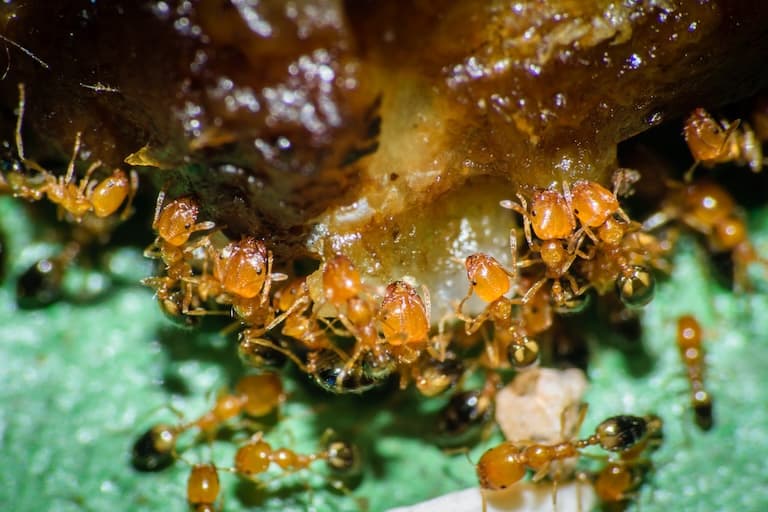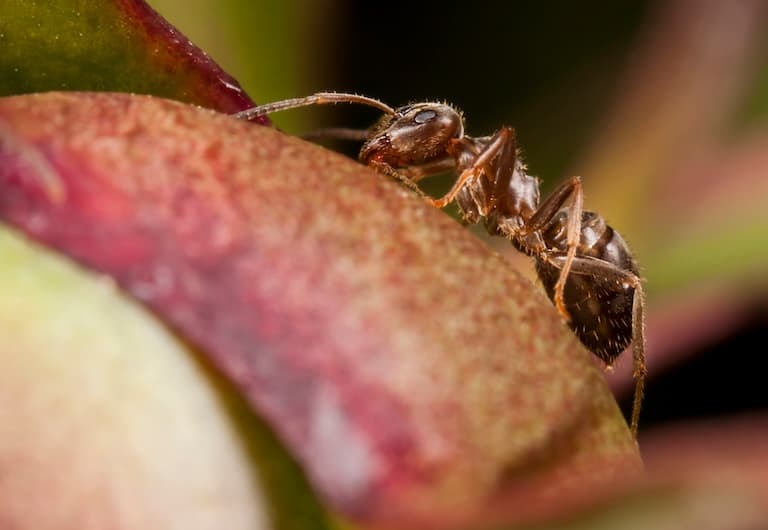Pharoah Ant Profile
What has wings, but doesn’t fly; has eyes, but does not see; and a stinger that doesn’t sting? In case you missed the answer to this riddle in the title case at the top of this page, it’s the pharaoh ant: a very small pest with a very big presence, almost everywhere in the world!

Pharoah Ant Facts Overview
| Habitat: | Very diverse. In cooler regions, primarily in buildings |
| Location: | Originally Afrotropical, now been introduced worldwide |
| Lifespan: | Unknown |
| Size: | 2 mm (1⁄16 in) long |
| Weight: | Tiny ant weight |
| Colour: | Light yellow to reddish brown, darker in the abdomen |
| Diet: | Eggs, fluids, other arthropods, seeds, grains, and nuts; fruit, nectar, sap, bandages |
| Predators: | Not well known |
| Top Speed: | Pretty standard ant pace |
| No. of Species: | 1 |
| Conservation Status: | Not listed |
Pharaoh ants are tiny little yellow ants with a lot of attitude. They are originally a tropical species but have spread all over the world using their ability to thrive in various cracks and crevices, as well as their unusual colony budding style of reproduction to bypass many of the restrictions that hinder other species.
They also eat more or less anything, including used bandages, which makes them pretty epic as survivors and really rather dangerous as pests.
Interesting Pharoah Ant Facts
1. They’re explorers
It’s not 100% exactly where this species originates, but it seems to be a tropical or subtropical ant, possibly coming from North Africa, but they have a strong preference for hot and humid conditions.
They’re members of a small subfamily of ants called Myrmicinae, which has about 140 species in it, and they are found worldwide.
Pharaoh ants are also found worldwide, but they’re not native – they hitched rides on various shipping vessels over the years and made use of human habitations to avoid the cold.
They’re now commonly found in hotels, apartment blocks, industrial buildings and zoos, and their success comes from a fairly unusual configuration of adaptations. 1

2. They have wings but do not fly
These are very small ants, with workers of around 2mm long, but the males and queens are bigger, at around 3 mm and 3.5 mm, respectively.
Like many ant species, they grow wings for their nuptial flights, but neither the males, nor the fertile queens, use them.
Within a few days after mating, these wings fall off anyway, and the queens get to work laying eggs for the rest of their lives. 2
3. They have stingers but do not sting
Ant stingers are interesting organs. They’ve evolved from ovipositors, the egg-laying tubes found queens but otherwise redundant in their sterile workers.
Many ant species have them, but over time, others have evolved them and lost them again, as in this species, where the stings are present in the workers but seemingly useless.
But these incredibly successful ants still have more things that seemingly don’t use!
4. They have eyes but do not see
This one is a bit of an exaggeration. Pharaoh ants can see, a bit, but their eyes aren’t very good. And of course, being ants, they spend a lot of time in the dark. So, instead of having good vision, they use a lot of other techniques to navigate through the darkness.
Hairs on their abdomen can tell what the weather is like. Those defunct stingers are used instead to lay chemical trails of pheromones to communicate what they’re experiencing to the ants around them, and they have very sensitive tactile antennae that can feel vibrations as well as pick up the pheromones of their friends.
But it’s not their senses that have led them to expand across the globe. These ants do things most species can’t.

5. They wash violently
Washing behaviour is weird in this species. It’s not uncommon for ants to wash – just like you (hopefully), ants strive to keep faeces and other dirt off their faces and bodies, especially after a long walk through the mud.
It also helps keep the colony safe from pathogens, but in this ant, there may be another quirky element to the behaviour.
Washing after a forage is commonplace, but these ants do it before a trip, too, and they do it differently. Before a forage, the ants will wash themselves so enthusiastically that they might even fall over, knocking into their family members in the process.
This strange ritual has no hygienic value and nobody knows quite why they do it, but it might be some kind of activity to trigger a group behaviour.
With colony animals like these, decisions are made in a group, based on a threshold of activity. Wobbly washing could signify a desire to go out, and if met with enough agreement, the threshold could be met and the decision could be made to do so. 3
6. They have many queens
Each pharaoh ant colony has multiple queens, which creates confusing colony dynamics. This species isn’t as territorial as other species and instead tolerates populations pretty well, creating areas in which the boundaries between colonies are indistinguishable.
They don’t have the same ID-checking system that other ants have, which means they can’t even tell themselves whether the ant next to them is one of theirs or one of another colony.
This means there’s plenty of room for mixing genes and explains why they don’t need to fly to do it. Each queen, therefore, only needs to lay around 400 eggs in her lifetime, as opposed to some single queens who may lay more than a thousand in just one day.
So, they spread by “budding”. Groups of ants with a handful of fertile males and females branch off and start their own colonies. And from there, other branches bud off, and then some mix back together again, and bud off again, and so on, until they’ve more or less colonised everywhere.
And it explains how there can be just so many of them in a small space.
7. So, they can become pests
This species is a major concern for some folks, particularly in the US and Canada, where they have moved into houses, hospitals, and even DNA labs, where they have become a contamination issue.
Being tiny and tenacious, they have great penetration into light fittings, locks, cracks in walls, and so on, where they can then breed, bud off, and take over. They also kill local ant colonies, displacing the native fauna in the process.
One of the most concerning effects of this comes from their hankering for dirty human bandages. 4

8. They love a good bandage
We all love sucking on someone’s old wound dressings, but most of us are at least respectful enough to wait until they’ve discarded them first, and then do it in the dark where nobody can watch.
Pharoah ants aren’t so polite and have been known to break into hospitals and try to infest medical bandages while the patient is still wearing them.
This is already pretty gross, but these ants carry with them potentially harmful bacteria, which can really cause problems for people in a vulnerable state of immunity. They spread Salmonella, Clostridium, and Staphylococcus, none of which you want in you.
University campuses and nurseries aren’t safe, either, and these ants have even been found drinking the moisture from the mouths of sleeping infants.
Pharoah Ant Fact-File Summary
Scientific Classification
| Kingdom: | Animalia |
| Phylum: | Arthropoda |
| Class: | Insecta |
| Order: | Hymenoptera |
| Family: | Formicidae |
| Genus: | Monomorium |
| Species: | pharaonis |
Fact Sources & References
- “Pharaoh Ant”, Orkin Canada.
- Daniel Morris, “Monomorium pharaonis pharaoh ant”, Animal Diversity Web.
- J.H. Sudd (1959), “Communication and recruitment in pharaoh’s ant, Monomorium pharaonis (L.)”, Science Direct.
- AntsCanada (2019), “Pharaoh Ant Invaders Killed My Entire Colony – SAD EPISODE”, YouTube.
